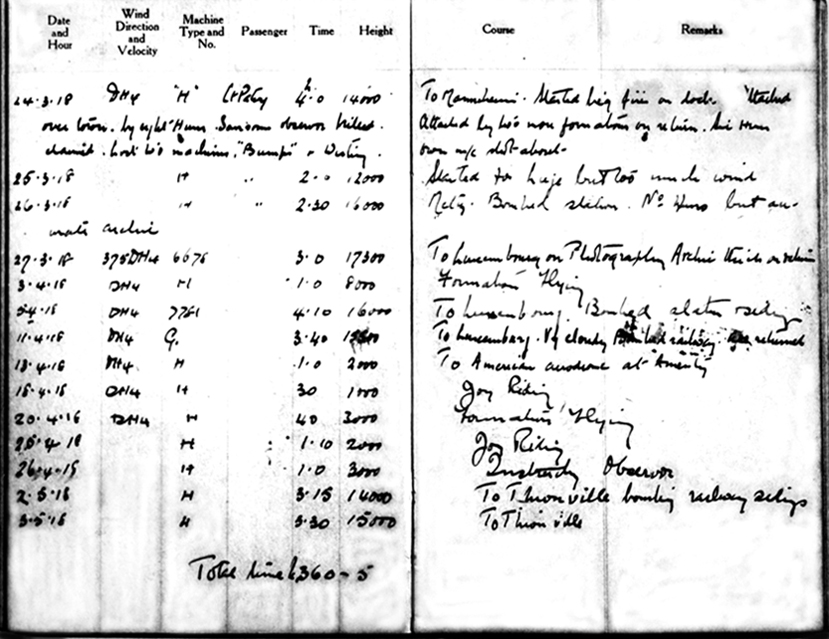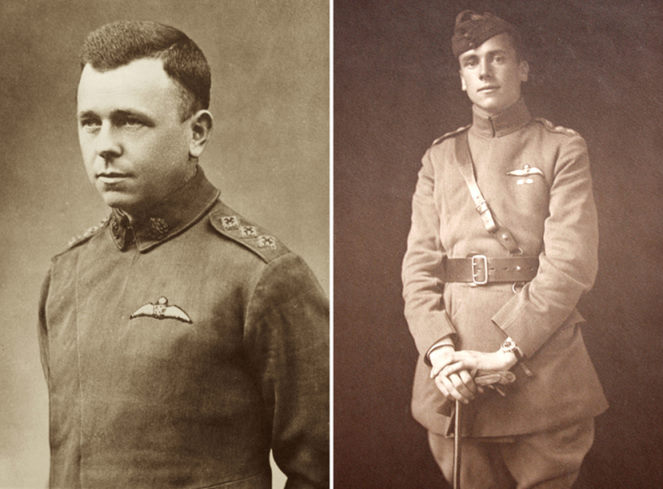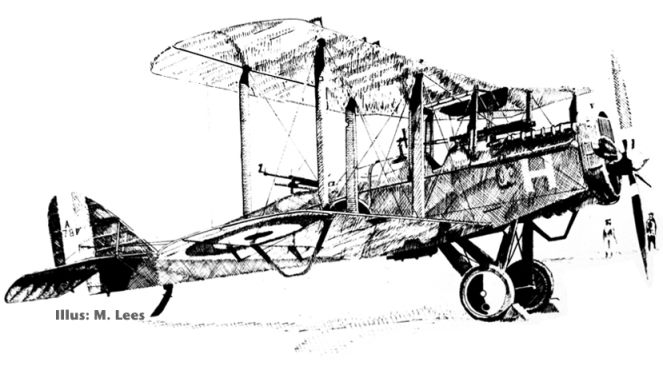55 SQUADRON DH4 OPS IN WW1 : MARCH-MAY 1918

55 SQUADRON LOG BOOK SPREADS
Two copy spreads have come to light recording some of 55’s missions in WW1 which give some insight of the times that it was experiencing during the Great War. This followed its formation at Castle Bromwich in April 1916 as a training unit during which time it flew BE2c, BE2e, Avro 504 and FK.8 aircraft, before taking the DH4 to its first posting abroad at Lilbourne, France, in June that same year. ‘55’ became operational as an Army Fighter and Reconnaissance Squadron early in 1917, under the command of Major J.L.A. Baldwin with DH.4’s powered by Rolls Royce Mk.111 Falcon engines, and armed with 1 Vickers & 1 Lewis gun while carrying a bomb load of 400lbs.
The handwriting is hard to read in a number of areas including place names, but on the first spread it begins “Posted to 55 Squadron RFC at Tantonvilleâ€. Nancy is given as the first destination beginning 12th March 1918, in DH4 7548, at a height of 3,000ft. A comment says “Saw no hun formation flyingâ€. A mission on 15th in 7292 (M) at 16,000ft records: “Bombs burst on factory, one red hun on my tail. Leading edge balance wire shot away, holes in tail, strut and main sparâ€. Thereafter a number of flight and height tests commenced on 21st Mar-23rd March, a full load giving a recorded speed of 90 knots at 6,500ft, while x 2 112lb bombs gave 86 knots at 10,000ft.
The first mission of the 2nd spread (illustrated above) is 24th March 1918, flown in a DH4 coded ‘H’ with a Lt. Patry listed as a passenger, attacking Manneheim, at 14,000ft with the remark ‘attacked over Loire’, with a fatality recorded. On 25th March the entry begins ‘Started for Liege but too much windâ€. The following day saw a raid at 16,000ft, commenting, ‘bombed station, no huns’. The 27th lists a photographic archive mission to Luxembourg at 17,300ft, after which the 18th, 20th & 25th April saw ‘joy riding’ and formation flying carried out as low as 1,000ft, while instructing an observor took place on 26th. A bombing mission was carried out on the railway sidings at Thionville on 5th May at a height of 14,000ft, with entries ending at the same location the following day. Total flying time to spread 2 is 360.5hrs.
Three months before the two log entries were written, 55 had the honour of being the first of the “Independent Force†to bomb Germany (Mannheim) in daylight on Christmas Eve, 1917. Photo Recce duties were undertaken, flying at 20,000 ft. and using oxygen masks. Bombing continued over all German towns in range, at the rate of 2 or 3 raids per day (see Issue 66 Mar 09).
At the time these logs were written 55 Squadron was commanded by Major A Gray, who assumed command in January 1918 until September that year, during which time the Squadron moved to Azelot, sharing the aerodrome with No.99 and 104 Squadrons, flying DH.9’s. Infantry support was carried out to the French around Verdun and our own troops during the Amiens retreat. The fluctuating fortunes of war are mirrored in 55’s base movements during the Great Conflict, which were nine in number.

Above: Capt Robert Robert Logan, M.C. and Capt Francis Turner M.C., D.F.C.
Captain Robert Logan of No.55 Sqn is seen as a POW, as taken at Schweidnitz German POW camp in 1917. He wears a Service Dress Jacket, often referred to as a ‘maternity jacket’ due to its straight cut exterior flap. His RFC wings are prominent over the left breast of his jacket, with large collar badges and three brass pips on the shoulder, which denote his rank. Robert Archibald Logan was the first Canadian civilian pilot to earn an officer’s commission in the British Royal Flying Corps and was shot down in April 1917, spending the rest of the war in German prison camps.
Logan’s DH4 was shot down on 8th April 1917 and his observer Frank F Henry was badly wounded. Disastrously 55 Squadron suffered three aircraft losses on this day, which were the first losses to be suffered by the unit in combat. Four aircraft had originally taken off to bomb the HQ of Crown Prince Rupprecht of Bavaria at Mons but sadly two aircraft were shot down when returning from the action, while the third was hit by AA fire (Again see Issue 66 Mar 09). The combat casualties were claimed by Lt Karl Schaefer of JASTA 11, otherwise known as the famous ‘Flying Circus’ of Baron Manfred Von Richthofen, ‘The Red Baron’, who also took part in the dogfight. Schaefer was trained to a high standard in aerial combat techniques by Richthofen, becoming close friends. By the time of Schaefer’s own death he had amassed his own score of 30 allied aircraft destroyed.
Frank F Henry was the Son of the Major of Edmonton in Canada and joined the PPCLI in late 1914. He was later commissioned as a scouting officer into the 49th Canadian Infantry Battalion, transferring to the RFC to become a Lieutenant Observer on the DH4 daylight bomber with No. 55 Squadron. Though Henry survived the war and returned home to his family he unfortunately died of illness in 1925.
Captain Francis Turner M.C., D.F.C. of 55 Sqn (full name Francis McDougall Charlewood Turner) was born 17th March 1897 and was to become a WW1 flying ace whilst serving in No. 55 Squadron RFC and later 57 Squadron (Bomber), being credited with 7 victories. He flew the DH4 with both the RFC and RAF. Flying with an observer his tally was composed of 3 kills with another 4 enemy aircraft lost due to going out of control.

